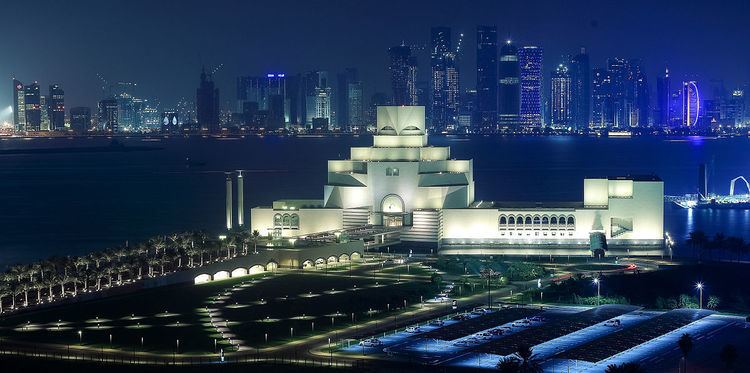Address Doha, Qatar | Type Art Museum Website www.mia.org.qa/en Opened 22 November 2008 | |
 | ||
Established 22 November 2008 (2008-11-22) Hours Open today · 10:30AM–5:30PMWednesday10:30AM–5:30PMThursday12–8PMFriday2–8PMSaturday12–8PMSunday10:30AM–5:30PMMonday10:30AM–5:30PMTuesdayClosedSuggest an edit Architects I. M. Pei, Jean-Michel Wilmotte Similar Souq Waqif, The Corniche, Sheikh Faisal Bin Qassim A, Aspire Park, Fanar - Qatar Islamic C Profiles | ||
The Museum of Islamic Art (Arabic: متحف الفن الإسلامي, matḥaf al-fann al-islāmī) is a museum located on one end of the seven kilometers long Corniche in the Qatari capital, Doha. As with the architect I. M. Pei's requirement, the museum is built on an island off an artificial projecting peninsula near the traditional dhow (wooden Qatari boat) harbor. A purpose-built park surrounds the edifice on the Eastern and Southern facades while 2 bridges connect the Southern front facade of the property with the main peninsula that holds the park. The Western and Northern facades are marked by the harbor showcasing the Qatari seafaring past.
Contents
Facilities
Facilities inside the 5-storied museum include temporary and permanent galleries, a gift shop, a library, a cafe, a 200-seat theater, classrooms and a restaurant. There are prayer rooms and ablution facilities inside to cater to Muslim visitors.
External facilities that form part of the crescent shaped MIA park include walking tracks, cycling tracks, a carousel, cafes, rest rooms and boat rentals.
MIA is part of Qatar Museums Authority. Admission to the museum and park are free. The park is open 24 hours to cater to residents of the city.
Architecture
The museum is influenced by ancient Islamic architecture, yet has a uniquely modern design involving geometric patterns. It is the first of its kind to feature over 14 centuries of Islamic Ar in the Arab States of the Persian Gulf.
Occupying a total area of 45,000 m2, the museum is located on an artificial peninsula overlooking the south end of Doha Bay. Construction of the building was done by a Turkish company, Baytur Construction in 2006. The interior gallery spaces were designed by a team of Wilmotte Associates. The museum was officially opened on November 22, 2008 by the then emir of Qatar, Sheikh Hamad. It opened to the general public on December 8, 2008.
At 91 years of age, the museum's architect, I. M. Pei had to be coaxed out of retirement to undertake this enterprise. He traveled throughout the Muslim world on a six-month quest to learn about Muslim architecture and history and read Muslim texts to draw inspiration for his design. Declining all proposed sites for the museum, he suggested a stand-alone island for the structure in order to avoid encroachments by other buildings in the future. It was built off an artificial peninsula, approximately 60m off the Doha Corniche and surrounded by a some-what crescent shaped 290,000 m2 park. Pei requested that the museum spaces be designed by his collaborator on the Louvre project, Wilmotte & Associates, who then assembled a design team including Plowden & Smith (conservation consultants), Isometrix Lighting + Design (lighting consultants), SG Conseil (AV Consultants) under Turner Projacs. Along with this design team, Leslie E. Robertson Associates was the structural engineer for the project.
Collection
The Museum of Islamic Art (MIA) represents Islamic art from three continents over 1,400 years. Its collection includes metal work, ceramics, jewelry, wood work, textiles and glass obtained from three continents and dating from the 7th to the 19th century.
The museum houses a collection of work gathered since the late 1980's including manuscripts, textiles and ceramics. It is one of the world’s most complete collections of Islamic artifacts, with items originating in Spain, Egypt, Iran, Iraq, Turkey, India, and Central Asia. i hate u wikepidea is horrible
